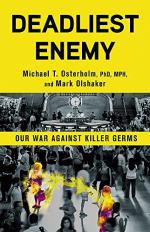
|
| Name: _________________________ | Period: ___________________ |
This test consists of 15 multiple choice questions and 5 short answer questions.
Multiple Choice Questions
1. Which animal does Osterholm think helped spread MERS to humans?
(a) Camels.
(b) Cats.
(c) Pigs.
(d) Dogs.
2. Which Florida Senator expressed alarm over mosquito-borne infections in the aftermath of the Zika outbreak?
(a) Rick Sanchez.
(b) Rick Scott.
(c) Jeb Bush.
(d) Marco Rubio.
3. Which writer does Osterholm begin Chapter 12 with a quote from?
(a) Mary Shelly.
(b) William Gibson.
(c) Ted Chiang.
(d) Roy Strong.
4. What word does Osterholm deliberately use when discussing the use of new antibiotics throughout history?
(a) Inventions.
(b) Discoveries.
(c) Serendipity.
(d) Stumbles.
5. What language does the word chikungunya come from?
(a) Indian.
(b) Makonde.
(c) Swahili.
(d) Malaysian.
6. Where did the 2012 outbreak of MERS seem to originate?
(a) Egypt.
(b) Israel.
(c) Saudi Arabia.
(d) Morocco.
7. Which cave remained untouched by humans or animals for almost four million years, until its discovery in 1986?
(a) Talahatche Cave.
(b) Lechugilla Cave.
(c) Ronalind Cave.
(d) Marcanuil Cave.
8. What are bacteriophages?
(a) Bacteria that have been extinct for a long time.
(b) Bateria that eat only iron.
(c) Viruses that can infect and kill certain bacteria.
(d) Bacteria that have been altered in labs to target viruses.
9. In the 1918 flu epidemic, which population suffered a disproportionately high number of deaths?
(a) Spanish people.
(b) Women.
(c) Young people.
(d) Old people.
10. What chemical that used to be commonly used to kill mosquitoes became a public health and environmental concern as the years went on?
(a) FBG.
(b) MMR.
(c) DDT.
(d) ERA.
11. In Chapter 17, which doctor does Osterholm identify as one of the first to demonstrate the importance of hand-washing?
(a) Dr. Bronwyn Mawbry.
(b) Dr. Ignaz Semmelweis.
(c) Dr. Richard Siemmler.
(d) Dr. Marco Iqubal.
12. What illness were doctors in cities along the Brazilian coast seeing a dramatic increase in in 2015?
(a) Marburg.
(b) Yellow fever.
(c) Influenza.
(d) Guillain-Barre.
13. Who is one of the leading independent journalists on public health, according to Osterholm in Chapter 16?
(a) Maryn McKenna.
(b) Colleen O'Mahr.
(c) Lola Navado.
(d) Marshall Winchell.
14. What illness did Osterholm's son turn out to have in Chapter 14?
(a) Ebola.
(b) La Crosse encephalitis.
(c) Cholera.
(d) Dengue fever.
15. What did Dr. Anne Schuchat say about the tools we had to fight SARS in 2003?
(a) They are dependent on people adhering to social distancing guidelines.
(b) They are entirely dependent on a successful vaccine.
(c) They were the same ones we have had for hundreds of years.
(d) They are all very expensive.
Short Answer Questions
1. What kind of virus are both the MERS and SARS viruses?
2. Which organ did an American health care worker harbor Ebola virus in for quite a while after he had been cured of the disease?
3. What publication did Osterholm almost pull an op-ed he wrote about Zika from in 2016?
4. Which doctor isolated the MERS virus in the 2012 outbreak?
5. When was Dengue first identified?
|
This section contains 476 words (approx. 2 pages at 300 words per page) |

|




